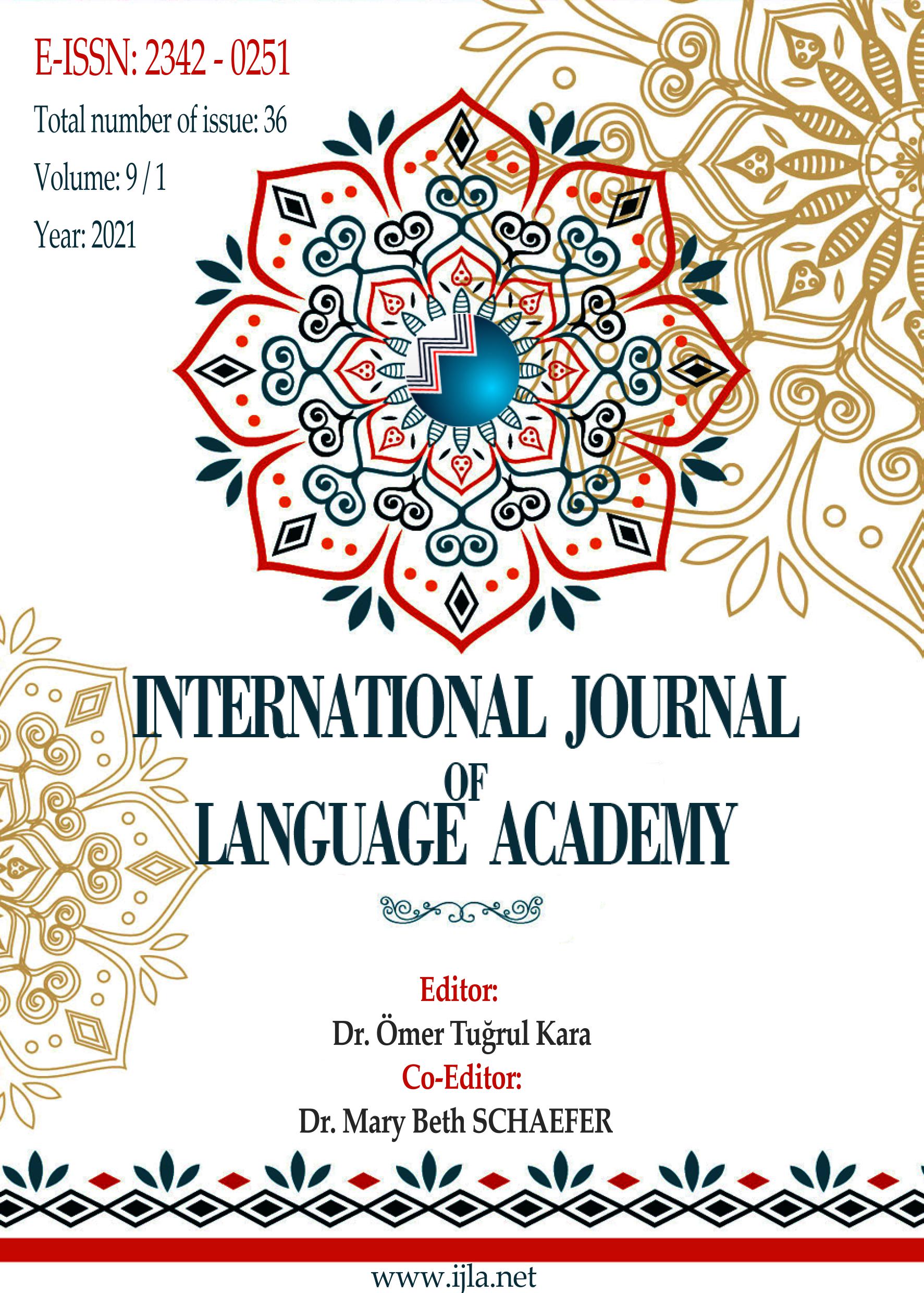SEKİZİNCİ SINIF TÜRKÇE DERS KİTABINDAKİ OKUMA METİNLERİNİN OKUNABİLİRLİK DÜZEYİNİN DEĞERLENDİRİLMESİ
Author :
Abstract
Türkçe ders kitaplarındaki metinler, öğrencilerin okuma becerilerini geliştirmek amacıyla öğretmenlerin yararlandıkları başlıca kaynaklardan biridir. Ders kitaplarında yer alan metinlerin hedef düzeye uygun olması ise bu becerinin öğrencilere sağlıklı bir şekilde kazandırılması için elzemdir. Bir metnin öğrenci düzeyine uygunluğunu belirlemeye yardımcı olan kıstaslardan birisi de metnin okunabilirlik güçlüğüdür. Bu çalışmanın amacı, Türkçe ders kitaplarında yer alan okuma metinlerinin okunabilirlik düzeylerini ölçmektir. Çalışmanın örneklemini 2020-2021 Eğitim Öğretim Yılı’nda sekizinci sınıf düzeyinde okutulmakta olan, MEB tarafından hazırlanmış Türkçe ders kitabındaki okuma metinleri oluşturmaktadır. MEB tarafından hazırlanan Türkçe ders kitabında yer alan öyküleyici ve bilgilendirici türdeki metinler çalışma kapsamına dâhil edilmiş, şiir ve tiyatro metinleri ise okunabilirlik formüllerinin uygulanmasına uygun olmadıkları için çalışma kapsamına dâhil edilmemiştir. Metinlerin okunabilirlik düzeylerinin belirlenmesinde Ateşman ve Çetinkaya-Uzun okunabilirlik formüllerinden yararlanılmıştır. Bu amaçla öncelikle incelenecek metinlerden en az yüzer kelimelik parçalar seçilmiştir. Daha sonra ilgili formüller için gerekli değişkenler olan metinlerdeki cümle sayısı ve hece sayısı değerleri bulunmuştur. Bu değerlerin okunabilirlik formüllerinde uygulanmasıyla metinlerin okunabilirlik güçlükleri ve düzeyleri elde edilmiştir. Metinlerin okunabilirlik düzeyleri metinlerin türüne göre kategorilendirilerek ele alınmıştır. Çalışma sonucunda incelenen metinlerin hedef sınıf düzeyine genel itibariyle uygun olduğu görülmüştür. Ayrıca ders kitabında yer alan metinlerin okunabilirlik düzeylerinin metin türüne göre farklılık gösterdiği, bilgilendirici türdeki metinlerin öyküleyici metinlere göre okunabilirlik düzeylerinin daha yüksek (okunmasının daha zor) olduğu, tespit edilmiştir.
Keywords
Abstract
The texts in Turkish textbooks are one of the primary resources teachers use to improve students' reading skills. The texts in the textbooks must be appropriate to the target level so that students can gain the skill correctly. One of the criteria that helps determine the suitability of a text to student level is the text's readability. This study aims to measure the readability levels of reading texts in Turkish textbooks. The study sample consists of the reading texts in the Turkish textbooks prepared by the Ministry of National Education, which is taught at the eighth-grade level in the 2020-2021 academic year. The narrative and informative texts included in the Turkish textbooks were included in the study, poetry and theater texts were not included because they are not suitable for the readability formulas. In determining the readability levels of the texts, Ateşman and Çetinkaya-Uzun readability formulas were used. For this purpose, pieces of at least 100 words from the texts to be analyzed were selected. Then, the number of sentences and the number of syllables in the texts, which are the necessary variables for the readability formulas, were counted. By using these variables in readability formulas, readability scores and levels of the texts were obtained. The readability levels of the texts are categorized according to the type of the texts. As a result of the study, it was seen that the texts examined were generally suitable for the target class level. Also, it was determined that the readability levels of the texts in the textbook differ according to the text type, and the readability levels of the informative texts were higher (more difficult to read) compared to the narrative texts.
Keywords
- Ateşman, E. (1997). Türkçede okunabilirliğin ölçülmesi. Dil Dergisi, 58, 71–74.
- Bağcı, H. ve Ünal, Y. (2013). İlköğretim 8. sınıf Türkçe ders kitaplarındaki metinlerin okunabilirlik düzeyi. Ana Dili Eğitimi Dergisi, 1(3), 12–28. https://doi.org/10.16916/aded.15997
- Bailin, A. ve Grafstein, A. (2015). Readability: Text and context. Houndmills, Basingstoke, Hampshire, New York: Palgrave Macmillan.
- Baş, B. ve İnan Yıldız, F. (2015). 2. sınıf Türkçe ders kitabındaki metinlerin okunabilirlik açısından incelenmesi. Mersin Üniversitesi Eğitim Fakültesi Dergisi, 11(1), 52–61. https://doi.org/10.17860/efd.28285
- Bezirci, B. ve Yılmaz, A. E. (2010). Metinlerin okunabilirliğinin ölçülmesi üzerine bir yazılım kütüphanesi ve Türkçe için yeni bir okunabilirlik ölçütü. Dokuz Eylül Üniversitesi Mühendislik Fakültesi Fen Ve Mühendislik Dergisi, 12(3), 49–62. https://dergipark.org.tr/en/pub/deumffmd/issue/40831/492667 adresinden erişilmiştir.
- Bormuth, J. R. (1968). Cloze test readability: Criterion reference scores. Journal of Educational Measurement, 5(3), 189–196. https://www.jstor.org/stable/1433978 adresinden erişilmiştir.
- Bowen, G. A. (2009). Document analysis as a qualitative research method. Qualitative Research Journal, 9(2), 27–40. https://doi.org/10.3316/QRJ0902027
- Corbin, J. ve Strauss, A. (2015). Basics of qualitative research: Techniques and procedures for developing grounded theory (Fourth edition). Los Angeles: SAGE.
- Çetinkaya, G. (2010). Türkçe metinlerin okunabilirlik düzeylerinin tanımlanması ve sınıflandırılması (Doktora tezi). https://tez.yok.gov.tr adresinden erişilmiştir.
- Çiftçi, Ö., Çeçen, M. A. ve Melanlıoğlu, D. (2007). Altıncı sınıf Türkçe ders kitaplarındaki metinlerin okunabilirlik açısından değerlendirilmesi. Elektronik Sosyal Bilimler Dergisi (Elektronik), 6(22). https://app.trdizin.gov.tr/makale/TnpZMU56YzM
- Dale, E. ve Chall, J. S. (1948). A formula for predicting readability. Educational Research Bulletin, 27(1), 11-20+28. https://www.jstor.org/stable/1473169 adresinden
- Durukan, E. (2014). Metinlerin okunabilirlik düzeyleri ile öğrencilerin okuma becerileri arasındaki ilişki. Ana Dili Eğitimi Dergisi, 2(3), 68–76. https://doi.org/10.16916/aded.26659
- Eselioğlu, H., Set, S. ve Yücel, A. (2019). Ortaokul ve imam hatip ortaokulu 8. sınıf Türkçe ders kitabı. Ankara: MEB.
- Flesch, R. (1948). A new readability yardstick. The Journal of Applied Psychology, 32(3), 221–233. https://doi.org/10.1037/h0057532
- Flory, S. M., Phillips, T. J. ve Tassin, M. F. (1992). Measuring readability: A comparison of accounting textbooks. Journal of Accounting Education, 10(1), 151–161. https://doi.org/10.1016/0748-5751(92)90022-W
- Fry, E. (1968). A readability formula that saves time. Journal of Reading, 11(7), 513–516, 575-578. http://www.jstor.com/stable/40013635 adresinden erişilmiştir.
- Greene, B. (2001). Testing reading comprehension of theoretical discourse with cloze. Journal of Research in Reading, 24(1), 82–98. https://doi.org/10.1111/1467
- Klare, G. R. (1974). Assessing readability. Reading Research Quarterly, 10(1), 62. https://doi.org/10.2307/747086
- MEB (2019). Türkçe dersi öğretim programı: (İlkokul ve ortaokul 1, 2, 3, 4, 5, 6, 7 ve 8. sınıflar). Ankara: MEB.
- Redish, J. (2000). Readability formulas have even more limitations than Klare discusses. ACM Journal of Computer Documentation, 24(3), 132–137. https://doi.org/10.1145/344599.344637
- Taylor, W. L. (1953). “Cloze procedure”: A new tool for measuring readability. Journalism Quarterly, 30(4), 415–433. https://doi.org/10.1177/107769905303000401
- Yıldırım, A. ve Şimşek, H. (2016). Sosyal bilimlerde nitel araştırma yöntemleri (Genişletilmiş 10. baskı). Ankara: Seçkin.





